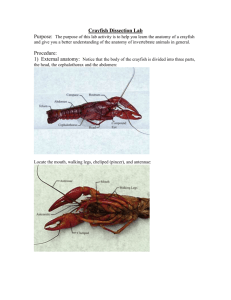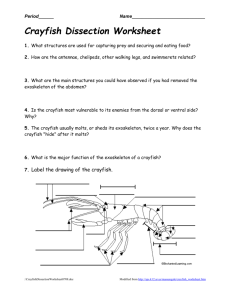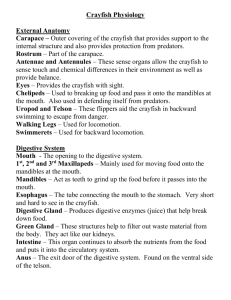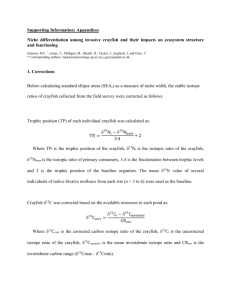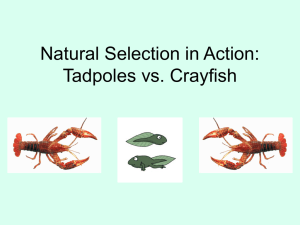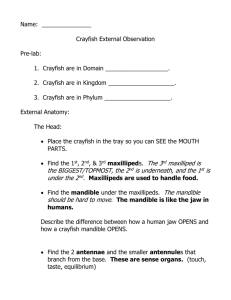MS WORD file - University of Kentucky
advertisement
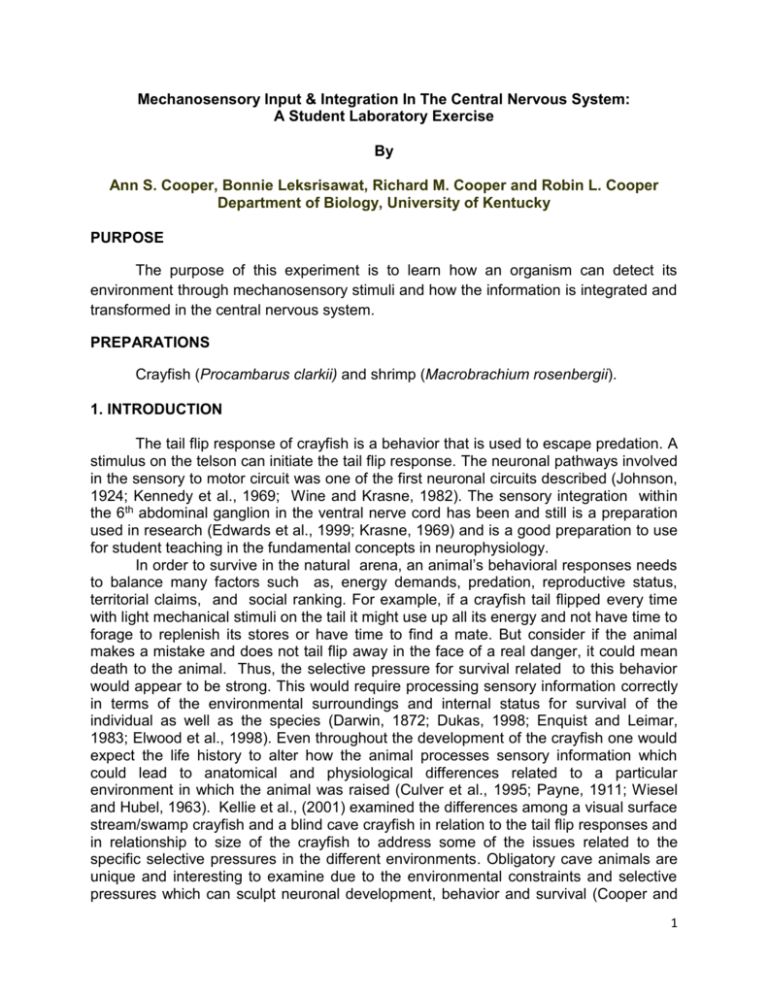
Mechanosensory Input & Integration In The Central Nervous System: A Student Laboratory Exercise By Ann S. Cooper, Bonnie Leksrisawat, Richard M. Cooper and Robin L. Cooper Department of Biology, University of Kentucky PURPOSE The purpose of this experiment is to learn how an organism can detect its environment through mechanosensory stimuli and how the information is integrated and transformed in the central nervous system. PREPARATIONS Crayfish (Procambarus clarkii) and shrimp (Macrobrachium rosenbergii). 1. INTRODUCTION The tail flip response of crayfish is a behavior that is used to escape predation. A stimulus on the telson can initiate the tail flip response. The neuronal pathways involved in the sensory to motor circuit was one of the first neuronal circuits described (Johnson, 1924; Kennedy et al., 1969; Wine and Krasne, 1982). The sensory integration within the 6th abdominal ganglion in the ventral nerve cord has been and still is a preparation used in research (Edwards et al., 1999; Krasne, 1969) and is a good preparation to use for student teaching in the fundamental concepts in neurophysiology. In order to survive in the natural arena, an animal’s behavioral responses needs to balance many factors such as, energy demands, predation, reproductive status, territorial claims, and social ranking. For example, if a crayfish tail flipped every time with light mechanical stimuli on the tail it might use up all its energy and not have time to forage to replenish its stores or have time to find a mate. But consider if the animal makes a mistake and does not tail flip away in the face of a real danger, it could mean death to the animal. Thus, the selective pressure for survival related to this behavior would appear to be strong. This would require processing sensory information correctly in terms of the environmental surroundings and internal status for survival of the individual as well as the species (Darwin, 1872; Dukas, 1998; Enquist and Leimar, 1983; Elwood et al., 1998). Even throughout the development of the crayfish one would expect the life history to alter how the animal processes sensory information which could lead to anatomical and physiological differences related to a particular environment in which the animal was raised (Culver et al., 1995; Payne, 1911; Wiesel and Hubel, 1963). Kellie et al., (2001) examined the differences among a visual surface stream/swamp crayfish and a blind cave crayfish in relation to the tail flip responses and in relationship to size of the crayfish to address some of the issues related to the specific selective pressures in the different environments. Obligatory cave animals are unique and interesting to examine due to the environmental constraints and selective pressures which can sculpt neuronal development, behavior and survival (Cooper and 1 Cooper, 2004; Voneida and Fish, 1984). A KY cave crayfish was examined for it responsiveness to light, vision, olfaction and telson stimulation as well as autonomic responsiveness to environmental cues (Kellie et al., 2001; Li et al., 2000; Li and Cooper 2002). Neuronal differences are present in the cave species which are suggestive of enhance olfactory abilities and a lack of visual sense (Cooper et al., 2001a; Ziemba et al., 2003). Life history and development of the animal alters the tail flip response. It has been observed that there a correlation in the occurrence of tail flipping during social interaction to size of the crayfish. The smaller crayfish tend to tail flip during an encounter with a larger crayfish where as the larger crayfish will more likely hold its stance or interact with its opponent (Pavey and Fielder, 1996). The developmental size of the neurons within the sensory-VNC-motor unit circuit was suggested to a factor related to the behavioral differences (Fricke, 1986). Edwards et al. (1994) had shown that depression- prone synapses of the sensory neurons is more prevalent for larger crayfish, which suggests that larger animals will show habituation quicker than smaller ones. When crayfish are given a tail touch every 30 sec, a large crayfish (Procambarus clarkii) will show habituation within about 10 minutes or within about 20 stimuli. However this is species dependent phenomenon (Figure 1; Pagé et al., 2007). Figure1: The lateral giant mediated tail flip response is induced by forcefully tapping the dorsal side of the telson. (A) Here a fire-polished glass rod is shown to tap the abdomen. When the crayfish exhibited a lateral giant mediated tail flip, a score of 1 was given and when a tail flip did not follow a tap on the telson, a 0 was recorded. The animal was tapped on the telson at 30 sec intervals and the scores were recorded to obtain an index of the rate of habituation to sensory stimulus (B). (Taken from Pagé et al., 2007). This size dependence is not hard wired as it can be rapidly altered. Lang et al. (1977) noted that that dominant lobsters which would rarely tail flip would rapidly start to tail flip during a social interaction when they lost their chelipeds by inducing them to autotomize. Thus, the dominate lobster would rapidly become submissive and tail flip to avoid the interaction. Such rapid alterations in the tail flip response were also demonstrated in crayfish (Pagé et al., 2007). With such a rapid change in the higher 2 CNS regulation of the tail flip it is unlikely that the change in responsiveness is due to receptor up or down regulation or alteration in synaptic structure. It has also been noted that in social interactions that there is a winner loser effect that can modulate this tail flip behavior (Copp, 1986). Descending neuronal input within the VNC was shown to alter the responsiveness of the tail flip induced behavior by telson stimulation. In addition, the responsiveness to serotonin (5-HT) is altered when the descending neural circuit is blocked suggesting that descending input influences the action of neuromodulation on the sensory-VNC-motor circuit (Pagé et al., 2007). It is known that the crayfish social structure impacts the willingness of the animal to tail flip to a given stimulus (Bruski and Dunham, 1987; Guiasu and Dunham, 1997). Consequently, in promoting the survival of the species, plasticity of the nervous system may play an important role in allowing the animal to rapidly adapt to threatening stimuli. In comparing the modulation of the escape behavior in sighted crayfish to the blind cave crayfish provided information that there are species differences which are likely related varied life histories and/or distinct differences in the processing of neuronal information (Kellie et al., 2001). Yeh et al. (1996) did show differences in dissected preparations of the telson sensory-VNC-Motor circuit in crayfish related to social status of animal. The influence of the neuromodulator 5-HT suggested difference in receptivity related to social status (Yeh et al., 1996). However it is unlikely this alteration in response to 5-HT is due to a chronic elevation of 5-HT within the hemolymph related to social status (Cooper et al., 2001a; Listerman et al., 2000; Pagé et al., 2007; Sparks et al., 2003; Strawn et al., 2000; Tabor and Cooper, 2002; see also- Edwards et al., 2002; Huber and Delago, 1998; Huber et al., 1997). One might expect some commonalities in behavior and associated processing of mechanosensory information in the 6th ganglion of the VNC in insects and crustaceans with similar anatomical arrangements and body plan. Such as a stimulus on one side of the caudal abdomen resulting in a reflexive withdrawal in the opposite direction away from the stimulus. This would likely involve similar cross processing of motor neurons and muscles. For example, much like the crustacean system discussed, the cockroach possess a caudal sense and an escape response. The ability of a cockroach to detect and suddenly respond to an approaching hand (‘predator’) has been attributed to the cerci and giant fiber system (Westin et al., 1977; Camhi et al., 1978). The cerci are a pair or horn-like, wind sensitive structures locate on the end of the abdomen. The receptor cell of each filiform hair is responsible for transducing the mechanical deflection of the hair into a neural event (resulting in a burst or inhibition of action potentials in the receptor cell’s axon; Westin, 1979). The APs travel to the terminal abdominal ganglion (A6) via cercal nerve, where they synapse with giant axons of the VNC (Figure 2). The giant axons are believed to be responsible for the transmission and subsequent excitation of motor neurons commanding escape behavior (Westin et al., 1977; Ritzmann, 1984; Ritzmann & Pollack, 1986). 3 Figure 2: Periplaneta americana shown with the cerci labeled (Top). A schematic of the ventral nerve cord exposed within the animal (Bottom). One can record from the primary sensory nerve (cercal nerve) or from connectives between ganglion The escape responses differ in which the environment the animal lives. The cockroach and crayfish walk on the substrate but a crayfish can flip up in the water column as well as move in the 2D plan on the surface. Among the bottom dwelling (i.e., benthic), crayfish (Procambarus clarkii) which tail flips and shoots up and forward or tail flips backwards, they are not found swimming throughout the water column as commonly observed for shrimp which can swim well in the water column for substantial distances. Macrobrachium rosenbergii is a species of shrimp that has been give a lot of attention over the years since it has gain popularity as a species for aquaculture as a food source, even in land locked locations such as Kentucky, USA. This species can become quite large and in one growing season reach 12 inches in length (New, 2004). Since they are relatively similar in body plan to crayfish and that they are swimmers within the water column it is of interest to compare and contrast their social behavior 4 and escape responses regarding tail flipping behavior to that of crayfish. Likewise the neuronal circuitry involved in the telson sensory –VNC- motor unit can be used for comparative purposes to relate to the particular behaviors of this species. One of the main problems in aquaculture of this species is their cannibalistic and aggressive nature when the density becomes large. It would be curious to learn if autotomizing the chelipeds throughout their development would help to maintain them in a submissive nature. Perhaps they would have a reduce growth rate if energy is spent in tail flipping often with each interactions? This species is gaining interest in neurobiology and role of neuromodulators (Tinikul et al., 2008, 2009). To account for the behavioral observations related to size, social status, rapid plasticity and species differences more research is required in understanding how the information from primary sensory neurons is integrated, modulated and how the descending inputs influence the sensory-VNC-motor unit circuit in the abdomen (Paul, 1991). Thus, reductionist approach in examining parts of this circuit have occurred over the years and research on this particular circuit remains active (Antonsen et al., 2005; Antonsen and Edwards, 2007; Bierbower and Cooper, 2010; Edwards et al., 1999, 2002; Kellie et al., 2001; Shuranova et al., 2006; Pagé et al., 2007; Wigginton et al., 2010). One now needs to pull pieces of information together to explain the plasticity of the circuit correlated to the various behaviors. In this series of experiments one will observe habitation to a sensory stimulus in an intact animal and potentially a modification of the habituation by removal of the claws. In addition, an in situ preparation will serve as a model to record from primary sensory neurons and observe how the signals are filtered by integration within the 6 th abdominal ganglion prior to relaying the information within the VNC. One will also observe the influence of a neuromodulator on the sensory drive and degree of activity within the ventral nerve cord. If time permits, one will make comparisons among a crayfish (Procambarus clarkia) and a shrimp (Macrobrachium rosenbergii) species. 5 Figure 3: Adult crayfish and shrimp used for these experiments. The top is the crayfish (Procambarus clarkia) and the bottom is the shrimp (Macrobrachium rosenbergii) used in these experiments. The shrimp has lost it’s right cheliped. Figure 4: The ventral view of the telson for the animals shown in figure 3. 6 2. MATERIALS & METHODS 2.1. Materials Scissors (1) Forceps (1) Silver Wire for ground wire (1) Microscope (1) Electrode Probe (1) Petri Dish with Sylgard on the bottom (1) Saline Solution (1) Potassium Solutions: 5.4mM (normal saline), 10, 20, 40, 80, 100 mM Bleach (Small Amount, Use for the tip of the silver wire to build Ag-Cl) Glass Pipette (1), to remove and add solutions Syringe (1) Amplifier/Acquisition System (1) Faraday Cage (1) Desktop/Laptop (1) Dissection pins (4) Crayfish/shrimp 2.2 Methods 2.2.1 Preparation/Dissection: 1. A crayfish approximately 6-10 cm in body length should be obtained (or a manageable size). Obtain the crayfish by holding it from the back of the head or approximately a centimeter from the back of the eyes. Ensure that the claws of the crayfish or mouth cannot reach the individual when handling the crayfish. (The crayfish maybe be placed in crushed ice for 5 minutes to anesthetize the crayfish prior to cutting off the head.) 2. Use the large scissors to quickly remove the head. Make a clean and quick cut from behind the eyes of the crayfish (Figure 5). Dispose of the head and appendages. 7 Figure 5: Image shows placement of the cut to remove the head of the crayfish. 3. The legs and claws of the crayfish can be removed at this point to avoid injury. Stylets on males and swimmerets on both males and females can also be removed (Figure 6). Next, separate the abdomen from the thorax. Make a cut along the articulating membrane which joins the abdomen and thorax (Figure 7). Save the abdomen portion of the crayfish and dispose of the thorax. Figure 6: The scissors are cutting the stylets. These can be removed from the crayfish. 8 Figure 7: Image shows the placement of the cut to remove the thorax from the abdomen. Figure 8: Removal of the thorax from the abdomen. The cut should be made in circular fashion along the line in the joining of the segments. 9 Figure 9: The top image shows the abdomen with swimmeret appendages. Bottom image shows the abdomen without the swimmeret appendages. 4. Place preparation in saline solution in a large Petri dish. Pin down the tail and upper portion of the preparation to the dish. Make sure the preparation is secure. Use a scalpel to cut the articulating membrane on the ventral side of the preparation on both sides of the last rib. In pinning the telson do not pin through the cuticle just to the sides to hold it in place and spread out (Figure 10). 10 (Figure 10) The 6th abdomen ganglion shown at the end of the black pointer. Notice the nerve roots branching out toward the telson. 5. Removed the last rib (most caudal) on the ventral side of the abdomen. Be careful not to damage the VNC. To do this cut the articulating membrane on both side of the rib along its length. Then slip one end of the stout scissors under the rib close to the mid line and cut the rib. Slightly move the scissors to the lateral sides, a short distance, and cut again. Thus, a mid section of the rib is removed the 6 th abdominal ganglion should be present. 6. Longitudinally cut the articulating membrane from where the 6th rib was to the 5th rib. Thus, exposing the connectives of the VNC from the 6th to the 5th abdominal ganglia. 7. The Petri dish with preparation should be placed under the microscope and secured with wax at the bottom of the dish to prevent movement. 2.2.2 Electrophysiology set up 11 Figure 11: Set up with suction electrode recording arrangement. 8. Position the micromanipulator in a position where the suction electrode has easy access to the saline bath. Suction up saline until it is in contact with the silver wire inside the suction electrode. Arrange the other wire close to the tip of electrode, so both wires will be in contact with the saline bath. At the tip of the glass suction electrode plastic tubing is placed with the correct size opening to pull the nerve into the tip with out coming out or being too tight which can damage the nerve. The plastic tubing is pulled over a flame and trimmed back to the size needed. Dissected preparations are bathed in standard crayfish saline, modified from Van Harreveld’s solution (1936), which is made with 205 NaCl; 5.3KCl; 13.5 CaCl 2; 2H2O; 2.45 MgCl2; 6H2O; 5 HEPES and adjusted to pH 7.4 (in mM). 9. As for the electrical monitoring connect the AC/ DC Differential Amplifier (amplifier) to the Power Lab 26T. Do this by connecting the proper cord from Input 1 on the PowerLab 26T to the output on the amplifier. The amplifier instrument controls should be set to the following settings: o High Pass- DC o Notch Filter- OFF o Low Pass- 20kHz o Capacity Comp.- counterclockwise o DC Offset Fine and Course knob- counterclockwise o DC Offset (+OFF-)- OFF o Gain knob- 50 o Input (DIFF MONO GND)- DIF o MODE(STIM-GATE-REC)- REC o ΩTEST- OFF Connect the head stage to the ‘input- probe’ on the amplifier. Connect the electrical wires from the suction electrode to the head stage. The wires should be connected with the red (positive) at the top left, green (ground) in the middle, black (negative at the bottom. This is indicated in Figure 12. The ground wire can just be put in the saline bath. Figure 12: Head stage configuration 12 10. Now connect the USB cord from the PowerLab 26T to the laptop. Ensure that both the amplifier and PowerLab26T are plugged in and turned on before opening LabChart7 on the computer. 11. Open LabChart7. o The LabChart Welcome Center box will pop open. Close it. o Click on Setup o Click on channel settings. Change the number of channels to 1 (bottom left of box) push OK. o At the top left of the chart set the cycles per second to about 2k. Set the volts (y-axis) to about 500 or 200mv. o Click on Channel 1 on the right of the chart. Click on Input Amplifier. Ensure that the settings: single-ended, ac coupled, and invert (inverts the signal if needed), and anti-alias, are checked. o To begin recording press start. 12. One could record from a root, an en passant recording, of the nerve that arises from the lateral uropod (these are the lateral aspects of the tail fan). Use a suction electrode and gently pull a segment of the nerve bundle into the electrode. Then brush on the telson/uropod with a fine paint brush. The paintbrush could be used by hand or for consistent stimulation it could be mounted on a micromanipulator to control the amount of pressure and movement. Collect the responses and save the computer file. 13. The suction electrode can now be moved onto the VNC. One can transect it close to the 5th ganglia in order to obtain a good seal with the suction electrode. Then brush on the telson/uropod with a fine paint brush again as was done earlier. Collect the responses and save the computer file. 14. Also stimulation of the cuticle with a brush while it is exposed to neuromodulators, such as serotonin (5-HT) (Strawn et al., 2000). One can now exchange the bathe with one containing a neuromodulator and repeat the brushing on the telson/uropod with a fine paint brush again as was done earlier. Collect the responses and save the computer file. One can also try heptanol (Johnston et al., 1980) or even CO 2 bubbled saline since it will uncouple the crayfish septate (or gap) junctions within the circuit as Dr. Sonya M. Bierbower (University of Kentucky) has shown in her dissertation research. This action may account for altered whole animal behavior when exposed to high CO2 in the environment (Bierbower and Cooper, 2010). 15. One can proceed in the same manner for a shrimp as was performed for the crayfish. Do note that the Macrobrachium rosenbergii has armor on its rostrum and a spine on its telson that can be very dangerous to the experimentor if the animal is not handeled correctly. Also, the chelipeds are able to bend around and reach behind the animals unlike a crayfish. So, hold on to the chelipeds when handeling this shrimp species. 13 2.2.3 Analysis of data To analyze the spike frequency recordings, one can count over a period time in different conditions. For example, prior to bush stimulation and during the stimulation for a given amount of time. One can repeated the conditions 5 times and the average percent change in frequency as an measure for comparisons. Also compare and contrast the recordings obtained from the sensory root as compared to the recorded of the connectives. DISCUSSION The details provided in the associated movie and text has provided key steps in order to sufficiently record from primary sensory nerves and interneurons in student run investigative laboratory to teach fundamental concepts in neurophysiology. The comparisons of various species for escape behaviors with a similar anatomical template as well as sensitivities to neuromodulators emphasis the use of various models to address similar questions. The exposure to a neural circuit can be used to explain associated intact animal behaviors has potential not only for students to investigate various open ended questions within their laboratory exercise but also for future research in dissecting out the neuronal circuits in well established invertebrate preparations (Kennedy et al., 1969; Antonsen and Edwards, 2003). ACKNOWLEDGEMENTS We thank Dr. Brian Antonsen (Marshall University, WV.) for helpful experimental suggestions with the crayfish. We thank Dr. James H. Tidwell (Aquaculture Research Center, KY State University, Frankfort, KY) for access to shrimp and guidance in rearing shrimp at the University of KY. REFERENCES Antonsen, B.L., and Edwards, D.H. (2007) Mechanisms of serotonergic facilitation of a command neuron. J. Neurophysiol. 98(6): 3494-504. PMID: 17898136 Antonsen, B.L., Herberholz, J., and Edwards, D.H. (2005) The retrograde spread of synaptic potentials and recruitment of presynaptic inputs. J. Neurosci. 25(12):3086-94. Bierbower, S.M. and Cooper, R.L. (2010) The effects of acute carbon dioxide on behavior and physiology in Procambarus clarkii. (In Press, Journal of Experimental Zoology). 14 Bruski, C.A. and Dunham, D.W. (1987) The importance of vision in agonistic communication of the crayfish Orconectes rusticus, I. An analysis of bout dynamics. Behaviour 63:83–107. Camhi, J.M., Tom, W. and Volman, S. (1978) The escape behavior of the cockroach Periplaneta Americana. II. Detection of natural predators by air displacement. J. Comp. Physiol. A. 128:203-212. Cooper, R.L., Chase, R.J., and Tabor, J. (2001a) Altered responsiveness to 5-HT at the crayfish neuromuscular junction due to chronic p-CPA & m-CPP treatment. Brain Research 916:143-151. Cooper, A.-S. and Cooper, R.L. (2004) Growth of troglobitic (Orconectes australis packardi) and epigean (Oroconectes juvenilis) species of crayfish maintained in laboratory conditions. Journal of Kentucky Academy of Sciences 65(2):108-115. Cooper, R.L., Li, H., Long, L.Y., Cole, J., and Hopper, H.L. (2001b) Anatomical comparisons of neural systems in sighted epigean & troglobitic crayfish species. Journal of Crustacean Biology 21:360-374. Copp NH. (1986) Dominance hierarchies in the crayfish Procambarus clarkii (Girard, 1852) and the question of learned individual recognition (Decapoda, Astascidea). Crustaceana. 51:7–24. Culver, D.C. (1987) Eye morphometrics of cave and spring populations of Gammarus minus (Amphipoda: Gammaridae). J of Crustacean Biology 7:136-147. Culver, D.C., Kane, T.C. and Fong, D.W. (1995) Adaptation and natural selection in caves. Cambridge, MA: Harvard University Press. Darwin, C. (1872) On the origin of species by means of natural selection, or the preservation of favoured races in the struggle for life. 6th ed. John Murray, London. Dukas, R. (1998) Cognitive ecology: The evolutionary ecology of information processing and decision making. Chicago: University of Chicago Press. Edwards, D.H., Heitler, W.J. and Krasne, F.B. (1999) Fifty years of a command neuron: the neurobiology of escape behavior in the crayfish. Trends Neurosci. 22:153–161. Edwards, D.H., Yeh, S.-R., Barnett, L.D. and Nagappan, P.R. (1994) Changes in synaptic integration during the growth of the lateral giant neuron of crayfish. J. Neurophysiol. 72: 899–908. Edwards, D.H., Yeh, S.R., Musolf, B.E., Antonsen, B.L. and Krasne, F.B. (2002) Metamodulation of the crayfish escape circuit. Brain Behav. Evol. 60(6):360-369. 15 Elwood, R.W., Wood, K.E., Gallagher, M.B. and Dick, T.A. (1998) Probing motivational state during agonistic encounters in animals. Nature 393:66–68. Enquist, M. and Leimar, O. (1983) Evolution of fighting behaviour: Decision rules and assessment of relative strength. J. Theor. Biol. 102:387–410. Fricke, R.A. (1986) Structure-function considerations in the developmental expression of crayfish behavioral plasticity. Proc 1986 IEEE International Conference on Systems, Man and Cybernetics 1:513–518. Guiasu, R.C. and Dunham, D.W. (1997) Initiation and outcome of agonistic contests in male form I Cambarus robustus Girard, 1852 crayfish (Decapoda, cambaridae). Crustaceana 70:480–496. Huber, R. and Delago, A. (1998) Serotonin alters decisions to withdraw in fighting crayfish, Astacus astacus: the motivational concept revisited. J. Comp. Physiol. 182: 573–583. Huber, R., Orzeszyna, M., Pokorny, N. and Kravitz, E.A. (1997) Biogenic amines and aggression: experimental approaches in crustaceans. Brain Behav. Evol. 50: 60–68. Huxley, T.H. (1880) The crayfish. C. London: Kegan Paul and Co. (This is a later edition that was not revised from a large paper edition limited to 250 copies published Nov. 29, 1879. (1880). Now available from MIT Press at http://www.mitpress.com) Johnson, G. E. (1924) Giant nerve fibers in crustaceans with special reference to Cambaus and Palaemonetes. J. Comp. Neurol. 36: 323-373. Johnston, M. F., Simon, S. A. and Ramon, F. (1980) Interaction of anaesthetics with electrical synapses. Nature (Lond) 286: 498-500. Kellie, S., Greer, J. and Cooper, R.L. (2001) Alterations in habituation of the tail flip response in epigean and troglobitic crayfish. J. Experimental Zoology 290:163-176. Kennedy, D. and Takeda, K. (1965a) Reflex control of abdominal flexor muscles in the crayfish: the twitch system. J. Exp. Biol. 43: 211–227. Kennedy, D. and Takeda, K. (1965b) Reflex control of the abdominal flexor in the crayfish: the tonic system. J. Exp. Biol. 43: 229–246. Kennedy, D., Selverston, A. I. and Remler, M.P. (1969) Analysis of restricted neural networks. Science 164:1488-1496. Kondoh, Y. and Hisada, M. (1986) Neuroanatomy of the terminal (sixth abdominal) ganglion of the crayfish, Procambarus clarkii (Girard). Cell and Tissue Research 243(2): 273–288. 16 Krasne, F.B. (1969) Excitation and habituation of the crayfish escape reflex: the depolarizing response in lateral giant fibres of the isolated abdomen. J. Exp. Biol. 50(1): 29-46. PMID: 4304852 Krasne, F.B. and Wine, J.J. (1975) Extrinsic modulation of crayfish escape behaviour. J. Exp. Biol. 63: 433–450. Krasne, F.B., Shamasian, A. and Kulkarni, R. (1997) Altered excitability of the crayfish lateral giant escape reflex during agonistic encounters. J. Neurosci. 17:692–699. Lang, F., Govind, C.K., Costello, W.J. and Greene, S.I. (1977) Developmental neuroethology: changes in escape and defense behavior during growth of the lobster. Science 197: 682–685. Li, H. and Cooper, R.L. (2002) The effect of ambient light on blind cave crayfish: Social interactions. Journal of Crustacean Biology 22: 449-458. Li, H., Listerman, L., Doshi, D., and Cooper, R.L. (2000) Use of heart rate to measure intrinsic state of blind cave crayfish during social interactions. Comparative Biochemistry and Physiology A.127: 55-70. Listerman, L., Deskins, J., Bradacs, H., and Cooper, R.L. (2000) Measures of heart rate during social interactions in crayfish and effects of 5-HT. Comparative Biochemistry and Physiology A.125: 251-264 New, M.B. (2004) Cultured Aquatic Species Information Programme. Text by New, M. B. In: FAO Fisheries and Aquaculture Department [online]. Rome. Updated 1 January 2004. [Cited 6 June 2010]. http://www.fao.org/fishery/culturedspecies/Macrobrachium_rosenbergii/en Olsen, Ø.H., Nadim, F., Hill, A.A.V. and Edwards, D.H. (1996) Uniform growth and neuronal integration. J. Neurophysiol. 76: 1850–1857. Pagé, M.-P., Hailes, W., and Cooper, R.L. (2007) Modification of the tail flip escape response in crayfish by neuromodulation and behavioral state with and without descending CNS input. International Journal of Zoological Research 3:132-144. Paul, D.H. (1991) Pedigrees of neurobehavioral circuits: tracing the evolution of novel behaviors by comparing motor patterns, muscles, and neurons in members of related taxa. Brain Behav. Evol. 38(4-5): 226-239 Pavey, C. R. and Fielder, D.R. (1996). The influence of size differential on agonistic behaviour in the freshwater crayfish, Cherax cuspidatus (Decapoda: Parasticidae). J. Zool. 238: 445–457. 17 Payne, F. (1911) Drosophila ampelophila bred in the dark for sixty-nine generations. Biological Bulletin 21:297-301. Ritzmann, R.E. (1984) The cockroach escape response. In: “Neural Mechanisms of Startle Behavior” Plenum Press, N.Y. pp 93-131. Ritzmann, R.E. and Pollack, A.J. (1986) Identification of thoracic interneurons that mediate giant interneuron-to-motor pathways in the cockroach. J. Comp. Physiol. A: 159:639-654. Shuranova, Z.P., Burmistrov, Y.M., Strawn, J.R., and Cooper, R.L. (2006). Evidence for an Autonomic Nervous System in Decapod Crustaceans. International Journal of Zoological Research 2(3): 242-283. Sparks, G.M., Brailoiu, E., Brailoiu, C., Dun, N.J., Tabor, J., and Cooper, R.L. (2003) Effects of m-CPP in altering neuronal function: Blocking depolarization in invertebrate motor & sensory neurons but exciting rat sensory neurons. Brain Research 969:14 - 26. Strawn, J.R., Neckameyer, W.S., and Cooper, R.L. (2000) The effects of 5-HT on sensory neurons, CNS command, and neuromuscular junctions of the crayfish abdominal superficial flexor. Comparative Biochemistry and Physiology B 127:533-550. Tabor, J. and Cooper, R.L. (2002) Physiologically identified 5-HT2 -like receptors at the crayfish neuromuscular junction. Brain Research 932:91-98 Tinikul, Y., Mercier, A.J. and Sobhon, P. (2009) Distribution of dopamine and octopamine in the central nervous system and ovary during the ovarian maturation cycle of the giant freshwater prawn, Macrobrachium rosenbergii. Tissue Cell. 41(6): 430-42. Tinikul, Y., Mercier, A. J., Soonklang, N., Sobhon, P. (2008) Changes in the levels of serotonin and dopamine in the central nervous system and ovary, and their possible roles in the ovarian development in the giant freshwater prawn, Macrobrachium rosenbergii. Gen. Comp. Endocrinol. 158(3): 250-258. Van Harreveld, A. (1936) A physiological solution for freshwater crustaceans. Proc. Soc Exp. Biol. Med. 34: 428-432. Voneida, T.J. and Fish, S.E. (1984) CNS changes related to the reduction of visual input in a naturally blind fish Anophtichthys hubbsi. American Zoologist 24: 775-782. Westin, J. (1979) Responses to wind recorded from the cercal nerve of the cockroach Periplaneta Americana. I. response properties of single neurons. J. Comp. Physiol. A 133:97-102 18 Westin, J. Langberg, J.J. and Camhi, J.M. (1977) Responses of giant interneurons of the cockroach Periplaneta Americana to wind puffs of different directions and velocities. J. Comp. Phyisol. A. 121:307-324. Wiesel, T.N. and Hubel, D.H. (1963) Effects of visual deprivation on morphology and physiology of cells in the cat’s lateral geniculate body. J. Neurophysiol., 26: 978- 993. Wigginton, A.J., Cooper, R.L., Fryman, E. and Birge, W.J. (2010) Effects of cadmium and body mass on the anti-predator behaviors of five species of crayfish. International Journal of Zoological Research 6(2):39-51. Wilkens, L.A. and Larimer, J.L. (1976) Photosensitivity in the sixth abdominal ganglion of decapod crustaceans: A comparative study. J. Comp. Physiol. A: Neuroethology, Sensory, Neural, and Behavioral Physiology. 106(1): 69–75. Wine, J.J. and Krasne, F.B. (1982). The cellular organization of crayfish escape behavior. In The Biology of Crustacea, vol. 4 (ed. D. E. Bliss), pp. 241-292. New York: Academic Press. Yeh, S.R., Fricke, R.A. and Edwards, D.H. (1996) The effect of social experience on serotonergic modulation of the escape circuit of crayfish. Science 271: 366–369. Yeh, S.R., Musolf, B. and Edwards, D.H. (1997) Neuronal adaptations to changes in the social dominance status of crayfish. J. Neurosci. 17: 697–708. Ziemba, R., Simpson, A., Hopper, R., and Cooper, R.L. (2003) Comparisons of aesthetasc sensilla on the lateral antennules between two epigean (surface) species and the blind cave crayfish Orconectes australis packardi. Crustaceana 76: 859-869. 19
